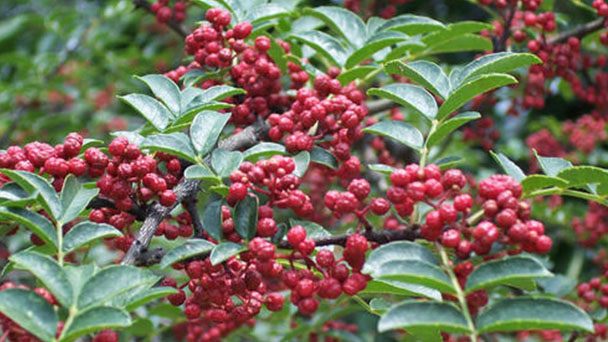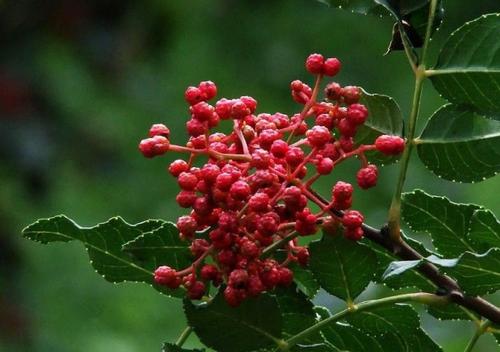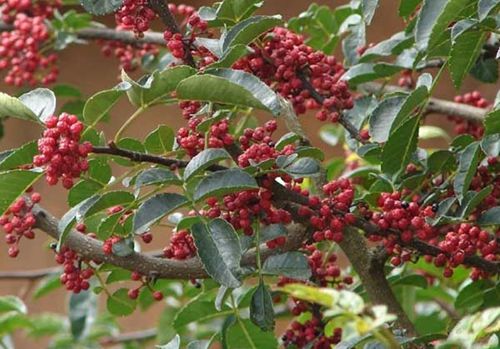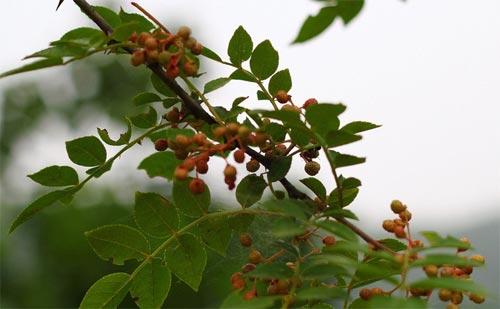Zanthoxylum bungeanum Maxim profile
Written by Maggie
Nov 16 2020

Zanthoxylum bungeanum Maxim is a small deciduous tree of the Rutaceae family and Zanthoxylum bungeanum; the thorns on the stem often fall early, and the branches have short thorns. The thorns on the branchlets have a wide, flat and straight long triangle at the base, and the original branches are pubescent.
Zanthoxylum bungeanum Maxim picture

Morphological characteristics of Zanthoxylum bungeanum Maxim
Zanthoxylum bungeanum Maxim is a deciduous shrub with a height of 3-7m. The stem usually has enlarged prickles; the branches are gray or brownish gray, with small lenticels and slightly upward prickles; the branchlets of the year are pubescent. Odd-pinnate compound leaves with narrow wings on the edge of the leaf shaft; 5-11 leaflets, papery, ovoid or oval-shaped, sessile or nearly sessile, 1.5-7cm long, 1-3cm wide, apex pointed or slightly concave, the base is nearly round, the edges are finely serrated, and the sides of the surface of the midvein base are often covered with a tuft of brown pilose, without needles.
The cymes are terminal, with 4-8 tepals; male flowers have 5-7 stamens, female flowers have 3-4 carpels, 6-7 rare, and ovary sessile.
The fruit is spherical, usually 2-3, red or purplish red, with dense, warty raised oil spots. Flowering period is from March to May, fruit period from July to September. zanthoxylum bungeanum Maximis light-loving, suitable for warm and humid soil, deep fertile loam and sandy loam, with strong sprouting, cold and drought tolerance, and strong disease resistance. Intolerance to waterlogging, short-term accumulation of water can cause death.
Zanthoxylum bungeanum Maximis a small deciduous tree with a height of 3-7 meters; the thorns on the stem often fall early, and the branches have short thorns. The thorns on the branch have a wide, flat and straight long triangle at the base, and the branches of the year are pubescent. The leaf has 5-13 leaflets, and the leaf axis often has very narrow leaf wings; the leaflets are opposite, sessile, ovate, elliptical, sparsely lanceolate, larger at the top of the leaf axis, and sometimes rounded near the base , 2-7 cm long, 1-3.5 cm wide, with fine cracked teeth on the leaf margin and oil spots in the teeth. The rest have no or scattered oil spots visible to the naked eye. There are tufts on both sides of the midrib of the back of the leaf, or both sides of the leaflets are pilose. The midrib is slightly concave on the leaf surface, and there are often reddish brown markings after the leaf back is dry. The inflorescence is terminal or born on the top of the lateral branches, the rachis and pedicel are densely pubescent or glabrous; the tepals are 6-8, yellow-green, approximately the same shape and size; the stamens of male flowers are 5 or as many as 8 ; The apex of the degenerate pistil is forked and lobed; the female flower has very few developed stamens, with 3 or 2 carpels, with 4 in between, the style is obliquely dorsi-curved. The fruit is purple-red, with a single petal of 4-5 mm in diameter, scattered with slightly raised oil spots, with short awn tips or none at the top; seeds 3.5-4.5 mm long. Flowering period is from April to May, fruiting period from August to September or October.
Zanthoxylum bungeanum Maxim growth environment
Production season: more than harvested around Mid-Autumn Festival. zanthoxylum bungeanum maxim is better to harvest after the Mid-Autumn Festival, harvesting too early will have less aroma, and harvesting too late will cause the fruit to fall off.
Zanthoxylum bungeanum Maxim can be found in the plains to higher mountains, and in Qinghai on the slopes of 2500 meters above sea level. It is also planted. Drought-tolerant, happy to the sun, planted everywhere.

Zanthoxylum bungeanum Maxim distribution range
Zanthoxylum bungeanum Maxim’s production is available in most regions of the country. The producing area starts from the southeast of the northeast, the north slope of Wuling in the south, the coastal areas of Jiangsu and Zhejiang in the southeast, and the southeast of Tibet in the southwest. It is not produced in Taiwan, Hainan and Guangdong.
Zanthoxylum bungeanum Maxim main value
Medicinal value
Warm to relieve pain, kill insects and relieve itching. Used for cold pain in the abdominal abdomen, vomiting and diarrhea, abdominal pain of worms, ascariasis; external treatment of eczema and itching
Edible value
Zanthoxylum bungeanum Maxim is normally to be Made of spices.
Other value

The wood of Zanthoxylum bungeanum is typically light yellow, and the color becomes slightly darker when exposed to the air. The difference between the heart and sapwood is not obvious. The xylem structure is dense and uniform. The longitudinal section has silky luster. The large wood has artistic value
Latest Updated
- Benefits of Bugleweed - 7 Science-backed Health Benefits
- Bugleweed Dangers & Side Effects - Is It Poisonous?
- How to Plant Evergreen Trees - What You Should Know
- When to Plant Evergreens - Grow Guide for Evergreen Trees
- 12 Wonderful Evergreen Shrubs for Your Garden
- 12 Popular Evergreen Plants with Pictures for Beginners
- When And How To Prune A Lilac Bush Like a Pro
- How to Grow & Care for Lilac Vine (Hardenbergia Violacea)
- Japanese Lilac Tree (Syringa Reticulata) Care & Propagation Guide
- Shumard Oak Pros and Cons - What to Know
Popular Articles
- Winter maintenance of Antirrhinum Majus
- How to Grow Terminalia Mantaly Tree
- How to Grow and Care for Crossostephium Chinense
- How to grow Antirrhinum Majus in spring
- Peristeria Elata (Dove Orchid) Profile: Info & Care Guide
- Underwatered Snake Plant (Sansevieria Trifasciata) - Signs And How To Fix
- How to Care for Brazilian Jasmine Plant (Mandevilla Sanderi)
- How to Grow & Care for Graptopetalum Purple Delight in Summer
- Rosa Chinensis (China Rose): Plant Growing & Care Tips
- How to Care for Baby Sun Rose (Aptenia Cordifolia)